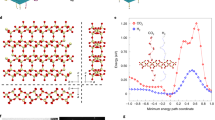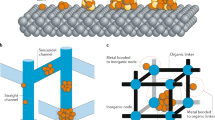Abstract
New porous materials such as zeolites, metal–organic frameworks and mesostructured oxides are of immense practical utility for gas storage, separations and heterogeneous catalysis. Their extended pore structures enable selective uptake of molecules or can modify the product selectivity (regioselectivity or enantioselectivity) of catalyst sites contained within. However, diffusion within pores can be problematic for biomass and fine chemicals, and not all catalyst classes can be readily synthesized with pores of the correct dimensions. Here, we present a novel approach that adds reactant selectivity to existing, non-porous oxide catalysts by first grafting the catalyst particles with single-molecule sacrificial templates, then partially overcoating the catalyst with a second oxide through atomic layer deposition. This technique is used to create sieving layers of Al2O3 (thickness, 0.4–0.7 nm) with ‘nanocavities’ (<2 nm in diameter) on a TiO2 photocatalyst. The additional layers result in selectivity (up to 9:1) towards less hindered reactants in otherwise unselective, competitive photocatalytic oxidations and transfer hydrogenations.
This is a preview of subscription content, access via your institution
Access options
Subscribe to this journal
Receive 12 print issues and online access
$259.00 per year
only $21.58 per issue
Buy this article
- Purchase on Springer Link
- Instant access to full article PDF
Prices may be subject to local taxes which are calculated during checkout




Similar content being viewed by others
Change history
09 November 2012
In the version of this Article originally published online, the affiliation for Sungsik Lee and Randall E. Winans was incorrect, it should have read 'X-ray Science Division, Argonne National Laboratory'. This has now been corrected in all versions of the Article.
References
Thomas, J. M. & Thomas, W. J. Principle and Practice of Heterogeneous Catalysis (VCH, 2005).
Satterfield, C. N. Heterogeneous Catalysis in Industrial Practice 2nd edn (Krieger, 1991).
Bartholomew, C. H. & Farrauto, R. J. Fundamentals of Industrial Catalytic Processes 2nd edn (Wiley, 2006).
Centi, G., Cavani, F. & Trifiro, F. (eds) Selective Oxidation by Heterogeneous Catalysis (Kluwer Academic, 2001).
Hoffmann, M. R., Martin, S. T., Choi, W. & Bahnemann, D. W. Environmental applications of semiconductor photocatalysis. Chem. Rev. 95, 69–96 (1995).
Csicsery, S. M. Shape-selective catalysis in zeolites. Zeolites 4, 202–213 (1984).
Corma, A., Fornes, V., Pergher, S. B., Maesen, T. L. M. & Buglass, J. G. Delaminated zeolite precursors as selective acidic catalysts. Nature 396, 353–356 (1998).
Ogino, I. et al. Delamination of layered zeolite precursors under mild conditions: synthesis of UCB-1 via fluoride/chloride anion-promoted exfoliation. J. Am. Chem. Soc. 133, 3288–3291 (2011).
Diddams, P. A., Thomas, J. M., Jones, W., Ballantine, J. A. & Purnell, J. H. Synthesis, characterization, and catalytic activity of beidellite-montmorillonite layered silicates and their pillared analogs. J. Chem. Soc. Chem. Commun. 1340–1342 (1984).
Chal, R., Gerardin, C., Bulut, M. & van Donk, S. Overview and industrial assessment of synthesis strategies towards zeolites with mesopores. ChemCatChem 3, 67–81 (2011).
Valiullin, R., Kärger, J., Cho, K., Choi, M. & Ryoo, R. Dynamics of water diffusion in mesoporous zeolites. Micropor. Mesopor. Mater. 142, 236–244 (2011).
Thomas, J. M., Hernandez-Garrido, J. C., Raja, R. & Bell, R. G. Nanoporous oxidic solids: the confluence of heterogeneous and homogeneous catalysis. Phys. Chem. Chem. Phys. 11, 2799–2825 (2009).
Kresge, C. T., Leonowicz, M. E., Roth, W. J., Vartuli, J. C. & Beck, J. S. Ordered mesoporous molecular sieves synthesized by a liquid-crystal template mechanism. Nature 359, 710–712 (1992).
Beck, J. S. et al. A new family of mesoporous molecular sieves prepared with liquid crystal templates. J. Am. Chem. Soc. 114, 10834–10843 (1992).
Tanev, P. T. & Pinnavaia, T. J. A neutral templating route to mesoporous molecular sieves. Science 267, 865–867 (1995).
Zhao, D. et al. Triblock copolymer syntheses of mesoporous silica with periodic 50 to 300 angstrom pores. Science 279, 548–552 (1998).
Thomas, J. M. & Raja, R. Exploiting nanospace for asymmetric catalysis: confinement of immobilized, single-site chiral catalysts enhances enantioselectivity. Acc. Chem. Res. 41, 708–720 (2008).
Katz, A. & Davis, M. E. Molecular imprinting of bulk, microporous silica. Nature 403, 286–289 (2000).
Tada, M. & Iwasawa, Y. Design of molecular-imprinting metal-complex catalysts. J. Mol. Catal. A 199, 115–137 (2003).
Shultz, A. M. et al. Selective surface and near-surface modification of a noncatenated, catalytically active metal-organic framework material based on Mn(salen) struts. Inorg. Chem. 50, 3174–3176 (2011).
Galarneau, A., Barodawalla, A. & Pinnavala, T. J. Porous clay heterostructures formed by gallery-templated synthesis. Nature 374, 529–531 (1995).
Cleveland, E. R., Banerjee, P., Perez, I., Lee, S. B. & Rubloff, G. W. Profile evolution for conformal atomic layer deposition over nanotopography. ACS Nano 4, 4637–4644 (2010).
Elam, J. W., Groner, M. D. & George, S. M. Viscous flow reactor with quartz crystal microbalance for thin film growth by atomic layer deposition. Rev. Sci. Instrum. 73, 2981–2987 (2002).
Libera, J. A., Elam, J. W. & Pellin, M. J. Conformal ZnO coatings on high surface area silica gel using atomic layer deposition. Thin Solid Films 516, 6158–6166 (2008).
Groner, M. D., Fabreguette, F. H., Elam, J. W. & George, S. M. Low-temperature Al2O3 atomic layer deposition. Chem. Mater. 16, 639–645 (2004).
Leskela, M. & Ritala, M. Atomic layer deposition chemistry: recent developments and future challenges. Angew. Chem. Int. Ed. 42, 5548–5554 (2003).
Jiang, X., Gur, T. M., Prinz, F. B. & Bent, S. F. Atomic layer deposition (ALD) co-deposited Pt-Ru binary and Pt skin catalysts for concentrated methanol oxidation. Chem. Mater. 22, 3024–3032 (2010).
Backman, L. B., Rautiainen, A., Lindblad, M. & Krause, A. O. I. The interaction of cobalt species with alumina on Co/Al2O3 catalysts prepared by atomic layer deposition. Appl. Catal. A 360, 183–191 (2009).
Christensen, S. T. et al. Controlled growth of platinum nanoparticles on strontium titanate nanocubes by atomic layer deposition. Small 5, 750–757 (2009).
Lu, J. et al. Coking- and sintering-resistant palladium catalysts achieved through atomic layer deposition. Science 335, 1205–1208 (2012).
Knez, M., Nielsch, K. & Niinistoe, L. Synthesis and surface engineering of complex nanostructures by atomic layer deposition. Adv. Mater. 19, 3425–3438 (2007).
Zhong, C. J. & Maye, M. M. Core–shell assembled nanoparticles as catalysts. Adv. Mater. 13, 1507–1511 (2001).
Joo, S. H. et al. Thermally stable Pt/mesoporous silica core-shell nanocatalysts for high-temperature reactions. Nature Mater. 8, 126–131 (2009).
Notestein, J. M., Iglesia, E. & Katz, A. Photoluminescence and charge-transfer complexes of calixarenes grafted on TiO2 nanoparticles. Chem. Mater. 19, 4998–5005 (2007).
O'Regan, B. & Graetzel, M. A low-cost, high-efficiency solar cell based on dye-sensitized colloidal titanium dioxide films. Nature 353, 737–740 (1991).
De Silva, N. et al. A bioinspired approach for controlling accessibility in calix[4]arene-bound metal cluster catalysts. Nature Chem. 2, 1062–1068 (2010).
Lee, S. et al. Selective propene epoxidation on immobilized Au6-10 clusters: the effect of hydrogen and water on activity and selectivity. Angew. Chem. Int. Ed. 48, 1467–1471 (2009).
Fox, M. A. & Dulay, M. T. Heterogeneous photocatalysis. Chem. Rev. 93, 341–357 (1993).
Zhang, M. et al. Oxygen atom transfer in the photocatalytic oxidation of alcohols by TiO2: oxygen isotope studies. Angew. Chem. Int. Ed. 48, 6081–6084 (2009).
Mallat, T. & Baiker, A. Oxidation of alcohols with molecular oxygen on solid catalysts. Chem. Rev. 104, 3037–3058 (2004).
Shen, X. et al. Inorganic molecular imprinted titanium dioxide photocatalyst: synthesis, characterization and its application for efficient and selective degradation of phthalate esters. J. Mater. Chem. 19, 4843–4851 (2009).
Ghosh-Mukerji, S., Haick, H., Schvartzman, M. & Paz, Y. Selective photocatalysis by means of molecular recognition. J. Am. Chem. Soc. 123, 10776–10777 (2001).
Llabres i Xamena, F. X. et al. Enhancement of the ETS-10 titanosilicate activity in the shape-selective photocatalytic degradation of large aromatic molecules by controlled defect production. J. Am. Chem. Soc. 125, 2264–2271 (2003).
Nishiyama, N., Miyamoto, M., Egashira, Y., & Ueyama, K. Zeolite membrane on catalyst particles for selective formation of p-xylene in the disproportionation of toluene. Chem. Commun. 1746–1747 (2001).
Foley, H. C., Lafyatis, D. S., Mariwala, R. K., Sonnichsen, G. D. & Brake, L. D. Shape selective methylamines synthesis: reaction and diffusion in a CMS–SiO2–Al2O3 composite catalyst. Chem. Eng. Sci. 49, 4771–4786 (1994).
Van der Puil, N. et al. Catalytic testing of TiO2/platinum/silicalite-1 composites. J. Chem. Soc. Faraday Trans. 92, 4609–4615 (1996).
Jones, C. W., Tsuji, K. & Davis, M. E. Organic-functionalized molecular sieves as shape-selective catalysts. Nature 393, 52–54 (1998).
Rabuffetti, F. A. et al. Synthesis-dependent first-order Raman scattering in SrTiO3 nanocubes at room temperature. Chem. Mater. 20, 5628–5635 (2008).
Acknowledgements
This material is based on work supported as part of the Institute for Atom-efficient Chemical Transformations (IACT), an Energy Frontier Research Center funded by the US Department of Energy (DOE), Office of Science, Office of Basic Energy Science. The authors thank K. Poeppelmeier for the gift of SrTiO3 nanocuboids. J.M.N. acknowledges a 3M Non-Tenured Faculty Grant, a DuPont Young Professor Grant, a Camille and Henry Dreyfus New Faculty Award and a US Department of Energy award (DE-SC0006718). S. Seifert and B. Lee are thanked for assistance with acquiring and analysing SAXS data. Use of the Advanced Photon Source, an Office of Science User Facility operated for the US DOE Office of Science by Argonne National Laboratory, was supported under contract no. DE-AC02-06CH11357. TEM was performed in the Electron Probe Instrumentation Center of NUANCE (supported by NSF-NSEC, NSF-MRSEC, Keck Foundation and the State of Illinois) at Northwestern University.
Author information
Authors and Affiliations
Contributions
C.P.C. grafted templates, performed TGA, UV-vis, N2 physisorption, TEM and catalysis experiments, and wrote the paper. N.A.G.G. performed catalysis experiments. J.L. and J.W.E. performed ALD with in situ QCM. S.L. and R.E.W. performed SAXS. N.A.R. performed ALD with supervision by P.C.S. and R.P.v.D. J.M.N. wrote the paper, managed the collaboration and developed the initial concept.
Corresponding author
Ethics declarations
Competing interests
The authors declare no competing financial interests.
Supplementary information
Supplementary information
Supplementary information (PDF 8017 kb)
Rights and permissions
About this article
Cite this article
Canlas, C., Lu, J., Ray, N. et al. Shape-selective sieving layers on an oxide catalyst surface. Nature Chem 4, 1030–1036 (2012). https://doi.org/10.1038/nchem.1477
Received:
Accepted:
Published:
Issue Date:
DOI: https://doi.org/10.1038/nchem.1477
This article is cited by
-
COx hydrogenation to methanol and other hydrocarbons under mild conditions with Mo3S4@ZSM-5
Nature Communications (2023)
-
Surface molecular imprinting over supported metal catalysts for size-dependent selective hydrogenation reactions
Nature Catalysis (2021)
-
Application of Fe-MOFs in advanced oxidation processes
Research on Chemical Intermediates (2019)
-
Replication of SMSI via ALD: TiO2 Overcoats Increase Pt-Catalyzed Acrolein Hydrogenation Selectivity
Catalysis Letters (2018)
-
Controllable cyanation of carbon-hydrogen bonds by zeolite crystals over manganese oxide catalyst
Nature Communications (2017)



